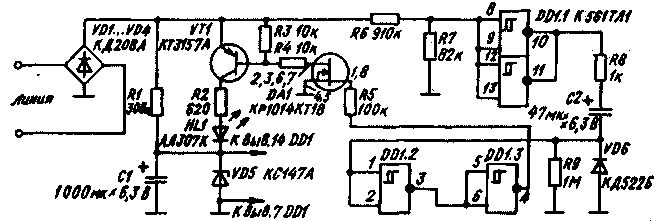The phone in the house - the need and the benefit. But once in the mailbox, you see the bill for talks with... Los Angeles or tel Aviv, where you never called. The explanation is simple - some free Amateur negotiations connected to a pair of wires of your telephone line (this can be done in and outside of your apartment). And to pay for the talks you have.
To prevent such cases, there are several ways. The simplest way for the period of your absence pick up the phone. However, PBX service is not welcome such a measure and can switch off the line. The second way is to apply for a PBX with a request to block your line for long-distance and international negotiations. But you will be deprived of such opportunities. And the third is to connect the lock set, such a device is also called "telephone watchdog". It connects or instead of the phone or parallel to it and allows you to dial any number. In standby mode watchdog almost no load on the line.

Diagram of the device shown in the figure. In the standby mode - the handset is not lifted or on the primary or on the "parallel" (in our case connected unauthorized) phones - when the device is connected in-line capacitor C1 is charged through the resistor R1 and rectifier bridge diodes VD1 - VD4 before stabilizing voltage VD5. The voltage at the inputs of the element DD1.1 (two element circuits DD1 is connected in parallel) corresponds to the log.1, the outputs of the log.0. The capacitor C2 is discharged, the output element D1.3 the log.0 key on the unipolar transistor circuits DA1 and the transistor VT1 closed. Current consumption from the line is less than 200 μa at the time of charging of the capacitor C1 and is reduced to 185 μa when fully charged.
The lock mode. When removing the handset on the main or the parallel machine, the voltage at the inputs of the element DD1.1 is reduced to a value that is smaller than the level of the log.0, and outputs a voltage is applied to the log.1. Begins charging the capacitor C2 with a time constant (t = C2-R9) about 47 C. during the charging process S2, the charging current generates a resistor R9 voltage greater than the trigger level element DD1.2. As a result, the output element DD1.3 (pin 4) sets the log.1. This opens the key DA1 and the transistor VT1. When opening VT1 line shunted by the resistor R2 and the led HL1, the voltage decrease in it and dialing is not possible. The led indicates off-hook on the main or the parallel phone.
After a certain time the current in the circuit of the resistor R9 falls elements and DD1.2 and DD1.3 is switched in a state in which the key DA1 and the transistor VT1 is closed. Shunt load is removed from the line. If the tube is still charged, then nothing much happens until, yet again, it will attempt to dial the number. The first two interrupts dialer lead to charging of the capacitor C2 and the process of incorporating a shunt load is repeated. If the tube is lowered, the voltage on the line exceeds 60 V and the device returns to the standby mode. The capacitor C2 discharges through resistor R8 and diode VD6 with a time constant of about 47 MS.
Normal operation of the device is possible only when you disable the lock that protects your phone in your absence from attempts to "pirate" line use.
In the device as a digital DD1 chip can be used TL, CTL, inverters without hysteresis CRL, CRL and inverters with high load capacity K561LN2.
Transistor VT1 DA1 and the key must be rated for the line voltage when the call signal (more than 90), so this chip with an alphabetic index And use is unacceptable. The transistor can be replaced by CTA, CTB,CTA.
The lock is assembled by a method of three-dimensional wiring without the use of a card and placed in a telephone plug-adapter.
Literature
Publication: N. Bolshakov, rf.atnn.ru






